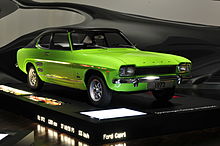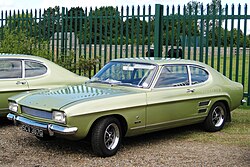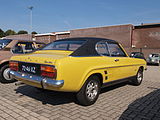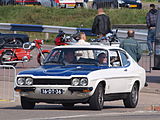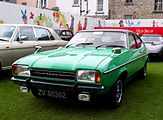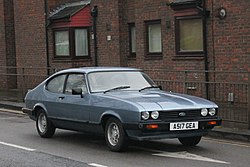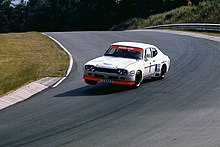Ford Capri
| Ford Capri | |
|---|---|
| Production period: | 1968-1986 |
| Class : | Middle class |
| Body versions : | Coupé , station wagon coupé |
The Ford Capri is a passenger car model from the automobile manufacturer Ford . Ford Germany built this sports coupé from November 1968 to December 1986. Ford of Britain produced it until October 1986.
The name Capri had been used earlier in the Ford Group: once in the US Lincoln Capri from the early 1950s and from 1962 to 1964 in the Ford Consul Capri , a coupé variant of the British Ford Consul Classic .
Capri '69 (1968–1973)
| First generation | |
|---|---|
|
Ford Capri (1968–1972) |
|
| Production period: | 11 / 1968-12 / 1973 |
| Engines: |
Petrol engines : 1.3-3.0 liters (37-110 kW) |
| Length: | 4186-4313 mm |
| Width: | 1646 mm |
| Height: | 1288 mm |
| Wheelbase : | 2559 mm |
| Empty weight : | 975-1140 kg |
The first Capri (internally Capri '69) was officially presented at the Brussels Motor Show in January 1969, and sales began in February.
With the Capri, Ford wanted to repeat the success the company had achieved with the Ford Mustang in the USA in Europe and offer a kind of European " pony car ". The chassis was taken over from the English Ford Cortina , the engines partly from the German Ford Taunus . It was manufactured in the British plants in Dagenham and Halewood , in Genk in Belgium and in the German Ford plants in Saarlouis and Cologne . The development name of the Capri was Colt ; But since the name was legally protected by Mitsubishi , Ford could not use it for its production model.
Ford wanted to cover as broad a spectrum as possible with the Capri, so it was offered with a large number of engine options. Ford Germany and Ford England each used different engines in the first few years: while in England the 1.3- and 1.6-liter inline four-cylinder of the Kent family were used, Ford Germany used its own V-engines with 1.3 , 1.5 and 1.7 liter displacement. The top engine was initially a two-liter V6.
Even more powerful engines were added by the end of 1969: in Germany the 108 or SHC engine with 125 hp 2300 GT with 2.3-liter twin carburetor V6, the 125 hp 2600 GT with 2.6-liter twin carburetor V6 and in Great Britain the 3000 GT with a Ford Essex three-liter V6 and 138 hp.
Special models
- In September 1970 a new 2.6-liter version of the Cologne V6 with Kugelfischer injection and 150 hp appeared in the Capri RS 2600 . It had twin headlights from the exported US version and the indicators from the US version were placed in the front of the apron under the headlights. For weight reasons (homologation in class 2) it had no bumpers until July 1971. After the factory holidays (band changeover) it got chrome-plated stub bumpers at the front and rear. It had additional air inlets at the front above the license plate, a chassis with Bilstein gas pressure shock absorbers, shortened coil springs and struts at the front and single-leaf springs with spacers at the rear, which lowered the body by approx. 50 mm, which resulted in excellent road holding. The engine of the RS was based on the 125 hp 2.6 L V6, but had a streaked long-stroke crankshaft with a stroke of 69 mm instead of 66.8 mm, which increased the displacement to over 2635 cm³. In addition, it was supposed to have a “sharper 300 °” camshaft, which would have exceeded the cheaper insurance class (up to 150 hp) (around 165–175 hp would have resulted). Therefore it only got a standard camshaft with 258 ° and thus still had over 160 hp. In those years Ford gave a nominal 150 hp. This was also common in America at the time in order not to overstrain insurance companies. It also had a more powerful oil pump, high-pressure valve springs, and an intake manifold developed by Harry Weslake and built near the Cologne factory with a mechanical Kugelfischer injection system and a higher-throughput double-flow exhaust system to the rear, with a manifold and two separate, oval tailpipes. The interior was equipped with cord-covered sports seats (initially without headrests) and a one-piece rear bench without a center armrest. The steering with a steering lock limiter was operated via a deep-seated AVO leather steering wheel on a black dashboard. This model served as the basis for various racing models.
- For use in the Capri 2600 GT , the slightly reduced displacement 2.6-liter engine of the Capri RS 2600 was equipped with a Solex double carburetor. The clutch and gearbox were painted red from the 26 M Taunus. The rear axle was initially geared to 3.22: 1 from the normal 2.6-liter model. From around August 1972, the rear axle with a ratio of 3.09: 1 from the British 3.0-liter model was used.
| Ford Capri: | 1300 | 1500 | 1700 | 2000 | 2300 | 2600 | RS 2600 |
|---|---|---|---|---|---|---|---|
| Engine: | 4-cylinder V-engine (four-stroke) | 6-cylinder V-engine (four-stroke) | |||||
| Displacement: | 1305 cc | 1498 cc | 1699 cc | 1998 cc | 2293 cc | 2550 cc | 2637 cc |
| Bore × stroke: | 84 x 58.86 mm | 90 x 58.86 mm | 90 x 66.8 mm | 84 x 60.14 mm | 90 x 60.14 mm | 90 x 66.8 mm | 90 × 69 mm |
| Performance at 1 / min: | 36.8 kW (50 hp) at 5000 |
44.1–47.8 kW (60–65 hp) in the 4800–5000 |
55.1 kW (75 PS) at 5000 |
62.5–66.2 kW (85–90 hp) in the 5000 |
79.4–91.9 kW (108–125 hp) on the 5100-5500 |
91.9 kW (125 hp) at 5300 |
110.3 kW (150 hp) at 5800 |
| Max. Torque at 1 / min: | 93 Nm at 2500 | 112-115 Nm at 2400-2500 | 127 Nm at 2500 | 148-152 Nm at 3000 | 181-183 Nm at 3000-3500 | 201 Nm at 3000 | 224 Nm at 3500 |
| Compression: | 8.2: 1 | 8.0-9.0: 1 | 9.0: 1 | 8.0-9.0: 1 | 9.0: 1 | 9.0: 1 | 10.0: 1 |
| Mixture preparation: | 1 downdraft carburetor | 1 register downdraft carburetor | 1 double downdraft carburetor | mechanical puffer injection | |||
| Valve control: | Bumpers and rocker arms (central camshaft, spur gears) | ||||||
| Cooling: | Water cooling | ||||||
| Transmission: | 4-speed gearbox, stick shift (a. W. three-speed automatic (Borg-Warner)) | ||||||
| Front suspension: | MacPherson strut axle , coil springs | ||||||
| Rear suspension: | Rigid axle with semi-elliptical leaf springs | ||||||
| Body: | Sheet steel, self-supporting | ||||||
| Track width front / rear: | 1346-1353 / 1320-1327 mm | ||||||
| Wheelbase: | 2559 mm | ||||||
| Length: | 4186-4303 mm | ||||||
| Empty weight: | 975-1060 kg | ||||||
| Top speed: | 133 km / h | 138-144 km / h | 148-152 km / h | 157-165 km / h | 175-185 km / h | 185-190 km / h | 202 km / h |
| 0-100 km / h: | 24 s | 18-21 p | 15-17 p | 12-15 s | 10-12 s | 10-11 s | 9 s |
| Consumption (liters / 100 kilometers): | 10.5 | 11-12 | 11.5-12.5 | 12.5-13.5 | 13.5-14.5 | 14.5-15.5 | 17th |
Facelift
From September 1972, the vehicle was offered as the Capri '73 in a revised form with rectangular or double headlights, indicators in the bumpers and enlarged rear lights, modified seats and a more comfortable chassis. The V4 engines were replaced by 1.3- and 1.6-liter in-line four-cylinder from the Taunus, the British 3.0-liter V6 was also available for the German Capri models, the 2.0-liter in-line four-cylinder was only installed in export versions.
1973 was the most successful year for the series with 233,000 units sold. In August 1973 the one millionth Capri rolled off the assembly line.
The Capri 2600 RS was also reissued in this version. It was recognizable by the split bumpers.
By the end of 1973, around 784,000 of the first series (including the Capri '73) had been built in Germany. Of these, 244,000 copies were sold in Germany.
| Ford Capri: | 1300 | 1600 | 1600 GT | 2300 | 2600 | 3000 | RS 2600 |
|---|---|---|---|---|---|---|---|
| Engine: | 4-cylinder in-line engine (four-stroke) | 6-cylinder V-engine (four-stroke) | |||||
| Displacement: | 1293 cc | 1592 cm³ | 1592 cm³ | 2293 cc | 2550 cc | 2993 cc | 2637 cc |
| Bore × stroke: | 79 × 66 mm | 87.7 x 66 mm | 87.7 x 66 mm | 90 x 60.14 mm | 90 x 66.8 mm | 93.7 x 72.4 mm | 90 × 69 mm |
| Performance at 1 / min: | 40 kW (55 PS) at 5500 |
53 kW (72 PS) at 5500 |
65 kW (88 PS) at 5700 |
79.5 kW (108 hp) at 5100 |
92 kW (125 PS) at 5300 |
103 kW (140 PS) at 5300 |
110.3 kW (150 hp) at 5600 |
| Max. Torque at 1 / min: | 90 Nm at 3000 | 118 Nm at 2700 | 124 Nm at 4000 | 181 Nm at 3000 | 201 Nm at 3000 | 235 Nm at 3000 | 216 Nm at 4000 |
| Compression: | 8.0: 1 | 9.0: 1 | 9.0: 1 | 9.0: 1 | 9.0: 1 | 8.9: 1 | 10.5: 1 |
| Mixture preparation: | 1 downdraft carburetor | 1 register downdraft carburetor | 1 double downdraft carburetor | mechanical puffer injection | |||
| Valve control: | hanging valves (overhead camshaft, toothed belt) | Bumpers and rocker arms (central camshaft, spur gears) | |||||
| Cooling: | Water cooling | ||||||
| Transmission: | 4-speed gearbox, stick shift (aW three-speed automatic (Borg-Warner)) | ||||||
| Front suspension: | MacPherson strut axle, coil springs | ||||||
| Rear suspension: | Rigid axle with semi-elliptical leaf springs | ||||||
| Body: | Sheet steel, self-supporting | ||||||
| Track width front / rear: | 1353-1392 / 1322-1327 mm | ||||||
| Wheelbase: | 2559 mm | ||||||
| Length: | 4240-4313 mm | ||||||
| Empty weight: | 975-1140 kg | ||||||
| Top speed: | 140 km / h | 150–155 km / h | 165-170 km / h | 175-180 km / h | 185-190 km / h | 193-198 km / h | 205 km / h |
| 0-100 km / h: | 21 s | 16-20 s | 13-16 s | 11-12 s | 10-11 s | 9-10 s | 9 s |
| Consumption (liters / 100 kilometers): | 10.5 | 12-13 | 12.5-13.5 | 13.5-14.5 | 14.5-15.5 | 15.5-16.5 | 17th |
Capri II '74 / '76 (1974–1977)
| Second generation | |
|---|---|
|
Ford Capri (1974-1976) |
|
| Production period: | 01 / 1974-12 / 1977 |
| Engines: |
Gasoline engines : 1.3-3.0 liters (40-102 kW) |
| Length: | 4240-4313 mm |
| Width: | 1698 mm |
| Height: | 1357 mm |
| Wheelbase : | 2559 mm |
| Empty weight : | 975-1140 kg |
Model history
As sales of the first Capri continued to decline, a major overhaul was necessary. The development was carried out under the name "Diana". The body received a tailgate and larger glass surfaces, which also responded to the criticism of the poor visibility in the Capri '69.
The floor pan and the technology were essentially taken over from the Capri '73. This is also the reason that many components are the same among the Capri series, such as sills, A-pillars or windshield. The wheelbase and the front track corresponded to the previous model, with the rear track widened by 56 mm. However, the weight increased due to the reinforcements required in the rear and the larger glass surfaces. All outer panels of the Capri have been smoothed.
Softer springs were also used to make the vehicle interesting for a less sporty target group. To counteract the trampling (torsional vibrations of the axle), the shock absorbers were alternately mounted on the axle (left behind, right in front of the axle tube). The forward-facing levers of the axle-mounted stabilizer acted as trailing arms to support the braking reaction torque.
The interior resembled the Capri '73 up to the B-pillar. The rear seats could now be folded down (also individually in the higher-quality models) and, in connection with the large tailgate, released a loading area large for sports car conditions.
The engines remained almost unchanged. Only the 1.3-liter engine was renewed, as Ford installed the cheaper “Kent” bumper motor, the design of which dates back to 1959, instead of the “Pintos” from 1970 with an overhead camshaft .
Sales of the Capri II started in February 1974, during the first oil crisis. This was also the reason why only 188 vehicles with the three-liter engine were sold in Germany in the first year.
Equipment lines
The Capri II was available in four trim levels, the base model was the Capri L. The XL version was a bit more luxurious, while the GT version was intended to appeal more to the sporty group of buyers. A new addition was the Capri Ghia , which replaced the old GXL version. As usual with Ford, the engines were only available in ascending order of equipment. It was not possible to order a six-cylinder for the L and XL versions. The small four-cylinder, however, were not offered in the Ghia and GT.
Facelift
In May 1976 the model range was reorganized. The L, GL, S and Ghia equipment levels replaced the previous L, XL and GT equipment levels. From October 1976 the entire Capri production was concentrated in the Saarlouis plant.
At the end of 1977, the Capri was withdrawn from the US market after 513,500 units had been sold there. At the same time, the production of the Capri '76 ended.
| Ford Capri: | 1300 | 1600 | 1600 GT | 2000 | 2300 | 3000 |
|---|---|---|---|---|---|---|
| Engine: | 4-cylinder in-line engine (four-stroke) | 6-cylinder V-engine (four-stroke) | ||||
| Displacement: | 1297 cc | 1592 cm³ | 1592 cm³ | 1999 cc | 2294 cc | 2993 cc |
| Bore × stroke: | 80.98 x 62.99 mm | 87.7 x 66 mm | 87.7 x 66 mm | 84.0 x 60.14 mm | 90.0 x 60.14 mm | 93.7 x 72.4 mm |
| Performance at 1 / min: | 40 kW (54 hp) at 5500 |
53 kW (72 PS) at 5500 |
65 kW (88 PS) at 5700 |
66 kW (90 PS) at 5000 |
80 kW (108 hp) at 5000 |
102 kW (138 hp) at 5300 |
| Max. Torque at 1 / min: | 89 Nm at 3000 | 118 Nm at 2700 | 124 Nm at 4000 | 150 Nm at 3000 | 181 Nm at 3000 | 235 Nm at 3000 |
| Compression: | 8.0: 1 | 9.2: 1 | 9.2: 1 | 8.75: 1 | 8.75: 1 | 9.0: 1 |
| Mixture preparation: | 1 downdraft carburetor | 1 register downdraft carburetor | 1 double downdraft carburetor | |||
| Valve control: | OHV | OHC, timing belt | Bumpers and rocker arms (central camshaft, spur gears) | |||
| Cooling: | Water cooling | |||||
| Transmission: | 4-speed gearbox, stick shift (aW three-speed automatic (Borg-Warner)) | |||||
| Front suspension: | MacPherson strut axle, coil springs | |||||
| Rear suspension: | Rigid axle with semi-elliptical leaf springs | |||||
| Body: | Sheet steel, self-supporting | |||||
| Track width front / rear: | 1353-1392 / 1322-1327 mm | |||||
| Wheelbase: | 2559 mm | |||||
| Length: | 4240-4313 mm | |||||
| Empty weight: | 975-1140 kg | |||||
| Top speed (automatic version) km / h: | 140 | 156 (151) | 168 (163) | 170 (166) | 178 (172) | 195 (190) |
| 0-100 km / h (automatic version) in s: | 23 | 16.4 (18.8) | 13.5 (16.1) | 14 (15.5) | 11.2 (12.6) | 8.9 (10.3) |
| Consumption (automatic version): in liters / 100 kilometers | 8.7 | 8.2 (11.5) | 9.2 (10.1) | 10.5 (11.3) | 8.8 (9.7) | 10.7 (11.5) |
Capri II '78 (1978-1986)
| Second generation (facelift) | |
|---|---|
|
Ford Capri (1978-1986) |
|
| Production period: | 01 / 1978-12 / 1986 |
| Engines: |
Petrol engines : 1.6-2.8 liters (51-138 kW) |
| Length: | 4376-4439 mm |
| Width: | 1698 mm |
| Height: | 1323-1357 mm |
| Wheelbase : | 2563 mm |
| Empty weight : | 1040-1250 kg |
Model history
The Capri II '78 presented in March 1978 was a heavily revised version of the Capri II '74 and was internally called "Project Carla". It represented a thorough model upgrade of the second generation.
Externally, the vehicle, unofficially known as the Capri III , was recognizable by a hood pulled over the twin headlights and a modified grill grille as well as encompassing bumpers. A small “spoiler” was also integrated into the front apron. These changes improved the aerodynamics, which not least benefited fuel consumption.
The rear axle was still designed as a leaf-sprung rigid axle .
Initially, the engine-gearbox combinations of the original Capri '74 were available unchanged, with the 3.0 S being the top model. The more comfortable 3.0 Ghia with automatic transmission sold better than the "S".
From spring 1981 the 2.0-liter and 3.0-liter V6 engines were discontinued, while the more modern 2.8 injection made its debut at the Geneva Motor Show .
From November 1984 the Capri was only built as a right-hand drive and sold in Great Britain.
When the Capri production was finally stopped in December 1986, a total of 1,886,647 copies had been made.
Special models
- The 2.8 injection was a sports version with a mechanical K-Jetronic injection system. The 2.8 liter V6 developed 160 hp and reached a top speed of 210 km / h, but was initially only equipped with a four-speed gearbox. With this "injection Capri", Ford revived the model series, which then remained in production longer than originally planned.
- The Capri Turbo was presented in the summer of 1981. The 188 hp V6 engine with a Garrett T04 B50 turbocharger was based on the 2.8 liter carburettor engine. It was a widened Capri '78 with 7.5 × 13-inch Ronal rims and 235/60 × 13 tires. It also had a large front spoiler, a rear wing and - like the 2.8injection - a sportier chassis with gas pressure shock absorbers, 25 mm lowering and reinforced stabilizers. The vehicle accelerated from 0 to 100 km / h in 8 seconds, with the top speed limited to 215 km / h. The equipment was similar to that of a Ghia with sports seats, large center console, RS leather steering wheel and special interior trim. The price was around 33,000 DM.
Production of the Capri 2.8 Turbo was limited to 200 copies, which is why it was terminated in mid-1982.
| Ford Capri: | 1.6 LC | 1.6 HC | 2.0 | 2.0 (V6) | 2.3 | 2.8 injection | 2.8 turbo |
|---|---|---|---|---|---|---|---|
| Engine: | 4-cylinder in-line engine (four-stroke) | 6-cylinder V-engine (four-stroke) | |||||
| Displacement: | 1593 cc | 1993 cc | 1999 cc | 2294 cc | 2792 cc | ||
| Bore × stroke: | 87.7 x 66 mm | 90.8 x 77 mm | 84.6 x 60.1 mm | 90 x 60.14 mm | 93 x 68.85 mm | ||
| Performance at 1 / min: |
51 kW (70 PS) 5300 |
54 kW (73 PS) 5300 |
74 kW (101 hp) 5200 |
66 kW (90 PS) 5100 |
84 kW (114 PS) 5300 |
118 kW (160 PS) 5700 |
138 kW (188 hp) 5500 |
| Max. Torque at 1 / min: |
113 Nm 2700 |
117 Nm 2700 |
153 Nm 4000 |
141 Nm 3000 |
176 Nm 3000 |
221 Nm 4300 |
263 Nm 4500 |
| Compression: | 8.2: 1 | 9.2: 1 | 9.2: 1 | 8.2: 1 | 9.0: 1 | 9.2: 1 | 9.2: 1 |
| Mixture preparation: | 1 downdraft carburetor | 1 register downdraft carburetor | 1 double downdraft carburetor | mechanical injection Bosch K-Jetronic | 1 double downdraft carburetor | ||
| Valve control: |
OHC overhead camshaft, rocker arm, timing belt |
OHV central camshaft, bumpers and rocker arms, spur gears |
|||||
| Cooling: | Water cooling | ||||||
| Transmission: | 4-speed gearbox, stick shift (aW five-speed gearbox or three-speed automatic (Ford C3)) |
||||||
| Front suspension: | MacPherson strut axle, coil springs | ||||||
| Rear suspension: | Rigid axle with semi-elliptical leaf springs | ||||||
| Body: | Sheet steel, self-supporting | ||||||
| Track width front / rear: | 1353-1400 / 1384-1431 mm | ||||||
| Wheelbase: | 2563 mm | ||||||
| Length: | 4376-4439 mm | ||||||
| Empty weight: | 1040-1250 kg | ||||||
| Top speed: | 155 km / h | 155-160 km / h | 175-180 km / h | 165-170 km / h | 178-183 km / h | 210 km / h | 220 km / h |
| Acceleration 0-100 km / h: |
16.5 s | 16-19 p | 13-14.5 s | 14-15.5 s | 12-13 s | 9 s | 8 s |
| Consumption in liters / 100 kilometers: |
11.5 | 11.5-12.5 | 13-14 | 13.5-14.5 | 13.5-14.5 | 15th | 15.5 |
Series designations
The Ford Capri was available in two main series, which received various modifications over time. However, it is common to divide it into three series. The chief designer responsible for all series was Uwe Bahnsen . Below is an overview of the commonly used and official series designations:
Capri (1968 to 1973)
| official name | - | Construction period |
| Capri '69 | - | 11/1968 to 08/1972 |
| Capri '73 | - | 09/1972 to 12/1973 |
Capri (1974 to 1977)
| official name | - | Construction period |
| Capri II '74 | - | 01/1974 to 05/1976 |
| Capri II '76 | - | 05/1976 to 12/1977 |
Capri (1978 to 1986)
| official name | - | Construction period |
| Capri II '78 | - | 01/1978 to 12/1986 |
In contrast to this, model names such as Capri MK1, MK2 and MK3 were also common in other European countries such as Great Britain.
Outside of Europe
In April 1970, Ford began selling the Capri in North America, South Africa and Australia.
- USA: The US versions, which were built exclusively at the Cologne plant, received double headlights, modified bumpers and did not have any branding; they were officially marketed as "Capri imported by Lincoln-Mercury" - and, like the De Tomaso Pantera , sold through Mercury dealers. After the VW Beetle, the Capri was at times the best-selling import model in the United States. In 1970 it was powered by a British Kent engine with 1600 cc and 64 hp, from 1971 by a two-liter in-line four-cylinder with 101 hp. From 1972 the Capri 2600 GT was also offered in the USA with the 2.6-liter V6 producing 120 hp. The export to the USA lasted until 1977.
- South Africa: Ford South Africa also imported the Capri from April 1970, preferably as a 3.0 GT. Many of these Capris were equipped with the five-liter V8 from Ford USA by the local specialist Basil Green Racing; these so-called Perana Capris competed with some success in the South African touring car championship and won the title for the 1970 season before they were excluded by the organizers. Some of the Capri II and II'78 also made it to South Africa.
- Australia: Ford Australia assembled the Capri at the Sydney plant from 1969 to 1972 from supplied parts kits . Originally the 1600 was offered in the basic and GT version with the British 1.6-liter in-line four-cylinder. In early 1970, a version with the Essex three-liter V6 and GT equipment was added. Due to a lack of demand, assembly was stopped in November 1972 after around 15,000 copies. Neither the Capri '73 nor the Capri II and II '78 were assembled in Australia, but 50 of the Capri RS 3100 were imported in 1973. From 1989 to 1994 a two-seater roadster based on the Mazda 323 was produced in Australia under the name Ford Capri and exported to the USA as the Mercury Capri .
Special models
Special models ex works were offered by the British Ford subsidiary, among others:
- Capri Cabaret (I and II; 1.6 and 2.0)
- Capri Calypso (I and II; 1.6)
- Capri Cameo (1.3 and 1.6)
- Capri GT4 (1.6 and 2.0)
- Capri Tempo (1.3 and 1.6)
In addition to the series models, special models such as the Tickford , convertibles from Deutsch and Halewood were also created. Even Aston Martin Capris were built. The designer Ing.Gerd Knözinger equipped Capris with V8 engines under the company name MAKO (33 Capri II and 17 Capri II '78). His vehicles, with a displacement of 4.9 liters and in various power levels, were equipped with the drive train and brake system of the Ford Mustang. The sale of the fast MAKO vehicles, however, ended in the early 1980s. Not all Makos got the V8 engine, some were "only" delivered with the 3-liter Essex engine. In Switzerland, a tuner also checked a conversion to the Ford V8 engine, but only in the 1990s. With this report, the tuner R. Bosshard would be free to convert other Capris to V8, but it remained with a single piece: a Capri II, which is still in his possession today.
In the summer of 1981 Ford brought out the Capri Turbo, which is probably the most sought-after today, in limited numbers. The vehicle, which was only produced in 200 copies, was only offered through the RS dealer network and could be distinguished from the normal Capri by various RS-typical features. The vehicles converted by Erich Zakowski in the Eifel have a marking on the transmission tunnel. The models with the 2.8-liter injection engine served as the basis, with the rear axle being fitted with a limited-slip differential. The 2.8 liter V6 with carburettor served as the drive. The air collector was labeled Ford . The turbocharger came from Garret and the boost pressure should not exceed 0.4 bar. The mechanical 4-speed gearbox came from the English production facility in Dagenham and was a series component from Granada and Capri with 2.6 and 3.0 l engines.
The appearance included flared fenders made of GRP, a front and a double rear spoiler, 235 / 60R13 tires on wide steel rims or, on request, with 7.5-inch Ronal aluminum rims and a different exhaust system. The interior was equipped with sports seats in gray velor fabric and a 4-spoke RS steering wheel. There is now a factory turbo forum in Switzerland, where all known vehicles are listed and drivers of such vehicles can exchange ideas. Other tuners such as Suhe, Wolf Motorsport or Gerstmann also offered both optical and technical accessories for the sports coupé.
Capri Tuning (Turbo) models (for public road traffic)
As early as 1970 there was a Capri I with a May turbocharger. This Capri, which had 108 HP as standard with the 2.3-liter engine, developed 180 HP at a boost pressure of 0.5 bar. The same system in a 2.6-liter with 125 hp let this increase to 207 hp. This was possible because the series engines had a compression ratio of only 9.0: 1. Only the cylinder head gaskets had to be reinforced to allow the engine to achieve this performance potential.
In the Capri II, only the 2.3-liter engine was charged between 1974 and 1978. At 180 hp, the performance corresponded to that of the Capri I with a 2.3-liter turbo.
In the Capri II '78 (or "Capri III", as it was popularly known), a 2.8-liter carburettor engine with 135 hp was charged to 188 hp at the factory. From the factory it was also equipped with a nitrided crankshaft and an oil pump with more delivery capacity. If you wanted more horsepower, the 2.8 liter injection could be tuned to approx. 215 horsepower with a turbocharger. Ford also offered the tuning of 2.3-liter V6 and 2.6-liter V6 engines to 2.6-liter RSV. For this, the crankshaft, camshaft, oil pump, exhaust manifold / system and various small parts of the engine had to be replaced in order to achieve an increase in performance to approx. 140 hp (which is slightly understated).
Motorsport
The Ford Capri RS 2600 is primarily considered a “cult car”. It was built from autumn 1970 until the end of the series in December 1973. This vehicle was equipped with a mechanical Kugelfischer injection system, which at that time was widely used in motorsport, but also in fast production vehicles such as the BMW 2002 tii . For the 2.6-liter engine, 150 hp were specified. This was an understatement. Most of the vehicles had between 160 and 170 hp, which explains the excellent performance at the time (0–100 in approx. 7.7 to 8.0 seconds at a top speed of 200 km / h). This vehicle was the basis for the company's own racing capris.
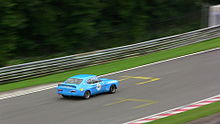
The Capri 2.6 RS was developed on the initiative of the then head of the Ford RS department Jochen Neerpasch and was used for homologation . In this context, a competitive version for private drivers was also offered ex works via the motorsport department. The so-called lightweight Capri had GRP doors with plastic windows and a GRP trunk lid. In the interior, the car was equipped with full bucket seats, without any insulation material for weight reasons. This light version had a carburetor instead of the Kugelfischer injection system.

For the competition version there was also a revised engine that was sold through the motorsport network. By boring from 90 mm to 93 mm, the displacement of this engine increased to 2.8 liters. You could choose between different carburettors or carburetor systems, sharper camshafts, larger valves, exhaust systems, a huge range of rims and chassis parts, spoilers, etc. This vehicle with a power-to-weight ratio of only 6 kg / hp was offered from 1970 to 1971.
For the Capri's maiden voyage in motorsport, two works 2300 GT V6 competed in the classic rally Stuttgart-Lyon-Charbonnières in March 1969. One team was made up of driver Jean-François Piot and Jean Todt , who later became the Ferrari team boss in Formula 1. In the second Capri, Dieter Glemser and Klaus Kaiser started, who finished fourth in the overall standings, while Piot and Todt ranked reached seven.
In 1970, the Ford motorsport department sent the two-door, equipped with six-cylinder naturally aspirated engines, into the race on three fronts: In the European Touring Car Championship, up to three cars started in the 2.3 GT and 2.4 GT versions, but were not very successful due to many failures. Even in the big rallies, the Capri RS and the 2.3 GT version did not achieve any brilliant triumphs. In the Hill Climb European Championship, the first RS 2.6 made his debut as a new addition to the driver Jochen Mass and in its first year he achieved the runner-up title. “The Capri RS was a sensational racing car for the touring car stand at the time,” said Mass. “The driving pleasure with the racing version was something special. However, you needed a lot of strength for the steering work. Depending on the racetrack, there were some bubbles, ”recalled the Ford works driver who became German circuit racing champion in 1971 and European touring car champion in 1972 with the RS.
The year 1971 became a season of records with the further developed Capri, which in the 2.9-liter version was now 280 hp. Dieter Glemser won the European Touring Car Championship in the over 2000 cc class, Jochen Mass dominated the German Circuit Championship with victories in all eight races of the season. With a team of ten factory drivers, the Capri managed 32 races all over the world and won the traditional touring car GP in Macau and the Springbok racing series in South Africa. The time between the individual races was so short at times that the mechanics were still working on the cars during the transport.
In the 1971 season, Hans Stuck switched to the Ford team as a driver, and the following year he went into the race with the now 300-hp RS with three-liter displacement. At the age of only 21, Stuck confidently secured the title in the first German Racing Championship (DRM) and only had to forego first place in one of ten races of the season. The naturally aspirated Capri with its new blue and white look also caused a sensation in the European Touring Car Championship. Jochen Mass won the title, fellow brand Dieter Glemser was runner-up. In the 24-hour race in Spa, the drivers of the three works Capri entered the first three places. In the endurance race in Le Mans, two of the three Capri entered, with a top speed of 270 km / h, fought for a double victory in the separately rated touring car classification.
Competitor BMW
In 1973 there was fierce competition between BMW and Ford. The works drivers Hans Stuck and Harald Menzel went to BMW in Munich. Jochen Neerpasch and chief technician Martin Braungart had already moved to the Bavarian camp during the preseason. Neerpasch's former assistant Michael Kranefuss and the newly committed technical manager Thomas Ammerschläger and their team competed against the strengthened BMW squad to defend their title. Bayern made their debut in the middle of the 1973 season with the BMW CSL Coupé. The car produced 400 hp and was clearly superior to the 3.0-liter engine of the Capri, which reached its performance limit with 325 hp. Ford did have plans for a 3.4-liter Cosworth engine with 400 hp, but these could not yet be implemented for homologation reasons. Ford had to cede the title in the European Touring Car Championship to the competition from Bavaria this season.
In 1974 Ford was able to field the Capri RS with a Cosworth engine against BMW. With new four-valve technology and over 415 hp, Formula 1 driver Niki Lauda, young talent Klaus Ludwig, Hans Heyer and Dieter Glemser competed. The Ford team won the drivers 'and manufacturers' titles in the European Touring Car Championship. Hans Heyer became European champion. In his first season as a works driver, the newcomer Klaus Ludwig immediately took third place in the DRM.

After that, the Capri was quiet for two years, as Ford had focused on the Escort model during this time. The Capri celebrated its racing comeback on July 29, 1978 at the Hockenheimring. Hans Heyer was behind the wheel of the Ford Zakspeed Turbo Capri 1.4. "The Turbo Capri was the ultimate car in touring car racing," enthused factory driver Heyer. “When we let the car off the leash for the first time as part of the Formula 1 Grand Prix in Germany, everyone was amazed. The best training time in the DRM in front of a full house right at the first start was something special. The long wheelbase, good aerodynamics and the power of the turbo engine offered unprecedented possibilities. From the cockpit, the boost pressure could be increased to 1.6 bar by handwheel in order to mobilize up to 600 hp for a short time. However, the engine was about to explode. "
The ultra-flat touring car with an aluminum tubular space frame was created by Ford partner Zakspeed and technically had nothing in common with the production model. The car was to recapture the title won by BMW in 1977 in the two-liter division of the DRM. In the last race of the season, Heyer achieved his first victory over BMW with the powerful four-cylinder, which has a displacement of just 1425 cm³ (× turbo factor 1.4 = 1995 cm³) and almost 400 hp. The next year, too, the Capri drivers Hans Heyer and Harald Ertl were unable to win the title, which Klaus Ludwig secured in the Kremer- Porsche 935.

Ludwig returned to Ford from Porsche in 1980. The previous year's Le Mans winner was supposed to compete against Porsche in the DRM division over 2000 cc with the 300 km / h Super-Capri. "The 1.8-liter turbo version was the uncompromising further development of the small 1.4-liter Zakspeed Turbo Capri from the years 78 and 79," explains the touring car star. “Depending on the boost pressure, the car could generate a maximum of 650 hp and was only for real artists. To be fast compared to the 700 hp Porsche, you had to touch the Super Capri with kid gloves. ”Ludwig fought for six victories of the season. Because the rear wing was too wide, the Bonn-born driver was subsequently deprived of two race results that he missed to win the title.
Only the next season became a Capri year again for Ford . At the wheel of the 560 hp Turbo Capri, Klaus Ludwig again attacked the 200 hp more powerful, but also heavier Porsche 935 Turbo. He won the title in the German racing championship that had been lost the previous year. Ludwig started from pole in all 13 races of the season and won ten races.
Then the Capri Turbo era slowly came to an end. Because of the decline in participants, sports cars were also registered in the DRM in 1982, against which the Capri had no chance in terms of performance. Cars and drivers were only granted minor successes. Five and a half years after its premiere, the Turbo Capri was therefore no longer used on the German racetracks at the factory.
4 × 4 Capris for rallycross
In the then still young auto sport called rallycross , the plant in Great Britain used two Capri 3000GT 4WDs (with Zodiac V6 engines) under rally factory driver Roger Clark and his brother Stan Clark between the beginning of 1969 and the end of 1971 and also supported the semi- Rod Chapman's factory car. At the end a good 250 hp 4 × 4 Capri (3-liter engines, CanAm gasoline injection, ZF transmissions and Ferguson - four-wheel drive equipped) were initially through many "teething" on, turned out in the course of Time, however, to such an extent that they were only allowed to start five or ten seconds ( 4WD penalty - depending on the respective race track) behind their opponents and were still often victorious.
Existence in Germany
The inventory of Ford Capris in Germany is listed as of January 1st (until 2000: July 1st) of selected years according to the Federal Motor Transport Authority . Before March 1, 2007, the vehicle inventory contained the number of vehicles registered as well as the number of temporary shutdowns. Since March 1, 2007, the vehicle fleet has only included "flowing traffic" including the seasonal license plates.
| Deadline | number |
|---|---|
| July 1, 1992 | 40,697 |
| Jan. 1, 2002 | approx. 5,250 |
| Jan. 1, 2005 | min. 3,990 1 |
| Jan. 1, 2008 | 2,685 |
| Jan. 1, 2009 | 2,650 |
| Jan. 1, 2010 | 2,523 |
| Jan. 1, 2011 | 2,514 |
| Jan. 1, 2013 | 2,584 |
According to the final report of the Federal Office for Economics and Export Control , 22 Ford Capri were scrapped in favor of the environmental bonus between January 27, 2009 and July 31, 2010.
Others
- January 2, 2016 gave the Federal Ministry of Finance in Germany, a special issue of the stamp series ' classic German cars " from a nominal value of 0.70 euros, on which the first generation of the Ford Capri is depicted.
literature
- Kim Henson: Ford Capri. Restoration manual; Purchase advice; Body and interior restoration; Modifications; technical data . (= Schrader-Motor-Technik Volume 7) Schrader-Automobil-Bücher, Munich 1991, ISBN 3-922617-79-4 .
- Johannes Kuhny: The Ford Capri Book . (A book from the "Type Series"). 2nd edition, Podszun-Motorbücher, Brilon 1991, ISBN 3-923448-52-X .
- Werner Oswald : German Cars 1945–1975 . Motor book, Stuttgart 1976.
- Chris Rees , Hermann Leifeld: Ford Capri. The cars and their history 1969–1986 . Motorbuch-Verlag, Stuttgart 1997, ISBN 3-613-01831-4 .
- Andreas A. Reil: The legend from Cologne. The history of the Ford Capri on DVD. Mediabook-Verlag, Gau-Heppenheim 2003, ISBN 3-932972-40-6 .
- Halwart Schrader , Ulrich Knaack (Red.): Ford Capri 1969–1987. A documentation (= Schrader type chronicle). Motorbuch-Verlag, Stuttgart 2007, ISBN 978-3-613-02712-1 .
- Bernd Tuchen: Ford Capri - Everything about the legendary sports coupé. GeraMond, Munich 2009, ISBN 978-3-7654-7716-4 .
- Bernd Tuchen: Classic exactly: Ford Capri I. Development, technology, data. Peter Kurz, Bremen 2013, ISBN 978-3-927485-32-7 .
- Günther Ulfik: The great Ford Capri book . 3rd edition, Heel, Königswinter 1992, ISBN 3-89365-271-X .
- Stefan Zerk: Ford Capri 1969–86. A documentation . (= Schrader-Motor-Chronik, Volume 57). Schrader, Suderburg-Hösseringen 1993, ISBN 3-921796-10-5 .
Web links
- http://www.auto-news-blog.de/ford-capri-kult-und-mythos/ Ford Capri I, II & III - model history of the Capri
- http://www.caprihome.de Large German Ford Capri Community
Individual evidence
- ↑ Model history
- ↑ Press release No. 4/2008. The vehicle inventory on January 1, 2008. (PDF; 120 kB) (No longer available online.) Federal Motor Transport Authority, archived from the original on October 16, 2013 ; Retrieved November 17, 2013 .
- ↑ a b Annual Report 2004. (PDF; 2.5 MB) (No longer available online.) Kraftfahrt-Bundesamt, p. 30 , archived from the original on March 26, 2014 ; Retrieved November 17, 2013 .
- ↑ Press report 2003. (PDF) Kraftfahrt-Bundesamt, 2004, p. 17 , accessed on January 16, 2018 .
- ↑ a b c Annual Report 2009. (PDF; 2.1 MB) (No longer available online.) Kraftfahrt-Bundesamt, p. 22 , archived from the original on October 29, 2013 ; Retrieved November 17, 2013 .
- ↑ Less and less Trabis. (PDF; 123 kB) (No longer available online.) Federal Motor Transport Authority, archived from the original ; Retrieved November 17, 2013 .
- ↑ Every 100th passenger car is a classic car. (PDF; 137 kB) (No longer available online.) Federal Motor Transport Authority, archived from the original on October 16, 2013 ; Retrieved November 17, 2013 .
- ↑ Final report - environmental bonus. (PDF; 1.6 MB) Federal Office for Economics and Export Control and Federal Motor Transport Authority, November 1, 2010, accessed on November 17, 2013 .
- ↑ Ford Capri 1, postage stamp at € 0.70, sheets of 10. In: deutschepost.de. Retrieved March 1, 2018 .
